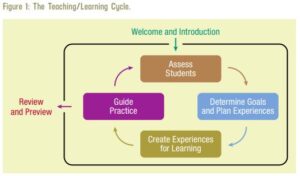
Why should games be a part of the learning process? There is scientific evidence that confirms games produce dopamine, a brain chemical that increases learning and stimulates our state of attention. Games can be characterized as competitive, rewarding, interactive, and attention-grabbing. Games present an opportunity to challenge students, eliciting curiosity and problem solving skills. Games are also just FUN!
How can we design games as an effective piece of the lesson that engages students?
Let’s explore the aspects of a game and break it down into smaller bites using some ideas from the Learning Cycle

Elements of a Game
 What is the goal of the game?
What is the goal of the game?
The goal of the instructor is for the learners to develop awareness by exploring skills that will help them be more successful in their lesson outcome(s). The goal of the game should be communicated at the outset to give the learner a target to reach.
 How do you focus on skill development?
How do you focus on skill development?
Learners need to know what they are expected to do and how the game is played in order to succeed. How you design the game is specific to these considerations:
- Student’s profile (age, skill level, equipment)
- Outcome
- Terrain available
- Time limitations
- Safety concerns
- Organization of participants and other objects
Next, provide instruction regarding the rules, structure, and boundaries of the game.
 What feedback will the participants receive while playing?
What feedback will the participants receive while playing?
A great resource for exploration and experimentation, games increase the intrinsic reward for success and lower the consequence of failure. Learners are motivated to try a variety of methods until they succeed, providing the learner with immediate feedback.
When focused, games can provide feedback to the learner about the results of their actions, the learner is able to change their choices and experiment with how they could improve their performance by problem-solving. Through problem solving the learner directs their actions and develops skills to succeed in the game.
Provide appropriate structure for the learner to experiment and develop awareness around the focused skill.
 How can you highlight the application and integration of skills through celebration?
How can you highlight the application and integration of skills through celebration?
When the goal is stated at the outset of the game, the learner will know when they have been successful. As a coach, you can use this moment where the learner knows they have accomplished the task by bringing awareness and acknowledgment around how the learner accomplished the task, what skills they used, and how they may have adapted those skills to solve the problem.
Celebrate the accomplishment of problem-solving. Acknowledge how the learner applies skills to face new challenges.
4 Types of Fun
If you can answer these four questions, you may hold the key to unlocking all 4 levels of fun. Give it a try!
Easy Fun
How can you create curiosity, wonder, and surprise for your students?
Hard Fun
How can you make something difficult and challenging to accomplish?
Social Fun
How do you create new opportunities for people to work together and be social?
Serious Fun
How do you get a sense of progression over time?
Did you see that? You just participated in a game. You were presented a challenge to find the answers for yourself. The questions were designed to focus your thoughts and ideas. The goal of this game was for you to generate awareness around the idea of fun based on your own personal experiences. Your mind may have explored options and found some appropriate answers and some that your mind immediately brushed off. Without noticing your mind had successes and failures.
Why did you participate? In this situation, curiosity or something else may have motivated you towards exploring this page for new insight or skill development. To find out more about fun, go outside and have a ton of it. Play games, card games, video games, snow games, any games. After you have played, think about the different elements of the game that drew you in, which types of fun the game involved, and how you can apply this to teaching snowsports.
Example of a Game
 Class Makeup: A group of 3, 5 year old beginner skiers
Class Makeup: A group of 3, 5 year old beginner skiers
Name of the Game: Train Tracks
Outcome: Move with your skis on from point A to point B
Boundaries
- Follow in a line behind the instructor or leader within a designated area on a flat slope.
- Keep your skis moving in the same path as the skier in front of you with a bit of space between each person.
Sensory Awareness Questions
- Visual: Pretend the tracks are painted lines, what color are you going to paint over the tracks with your skis?
- Kinesthetic: What part of your body is working the hardest when you slide over the tracks?
- Auditory: What sounds do your skis make when they slide over the tracks?
Change – How can I adapt this game?
- If the game is too easy you can choose terrain with a slight slope or create an obstacle course by placing objects in the path that the skiers will have to jump over or tap with their ski on the way by.
- If the game is too hard you could introduce polls or assign a leader and assist any students who are struggling.
- Connect to students hobbies or interest. For example if the group is interested in race cars, you can change the name of the game to “Indy 500” and introduce race car sounds when students go around corners, pick up speed or come to a stop.
High Fives
- When student arrive at the end point or “train station” encourage everyone who is already there to make a train “choo choo” sound to celebrate each students arrival.
- Encourage students along the way by recognizing their effort, remember that your students are most likely trying this for the first time.
Hopefully this example provides you with some framework by which you can develop and explore creative ways to play and engage your students. This game can just as easily work for snowboarders when teaching them how to skate.
If you would like more ideas for games, you can always reach out to other instructors and supervisors. I’m sure you will be pleasantly surprised by the creativity and ingenuity of the people around you. I can’t wait to see the games you create out on the hill.
Remember, the purpose of a game is to resolve conflict or succeed through a challenge. The challenge for the task should match the skill level of the learner. Providing an adequate challenge is introducing one that it’s not too easy to bore students and not too hard to resolve. Build into each game a way for the learner to know how successful they are.
Facilitate the game by allowing space and offering support when necessary to keep the learner in the flow. Be ready to adjust the variables of the game to increase or decrease the challenge.
